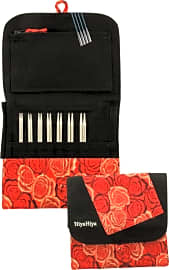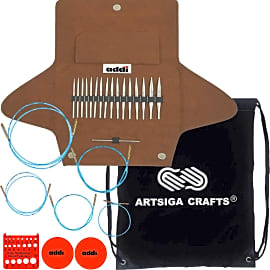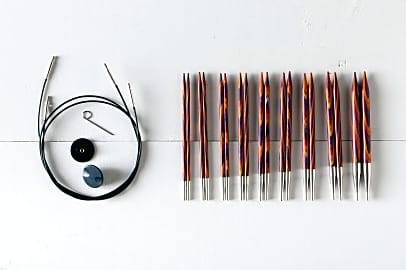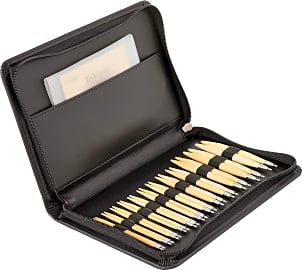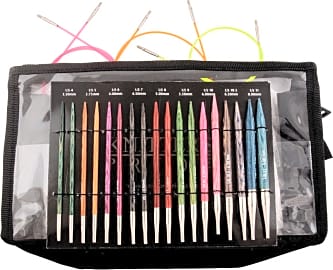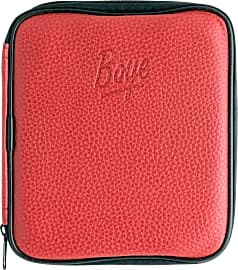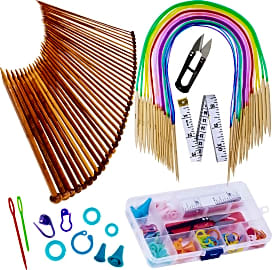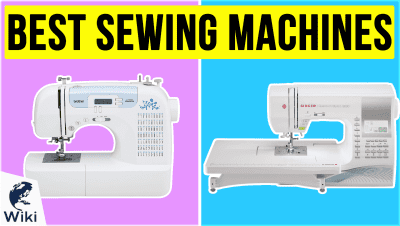The 10 Best Knitting Needle Sets

This wiki has been updated 45 times since it was first published in March of 2015. For those of you who are seeking some way to relax and forget about the stresses of the day, knitting can be a great way to zone out while also creating useful end products, like hats, scarves, socks, and even blankets. Whether you're an expert or just a beginner, you can find the needle set that's perfect for you by checking out our top picks, which include both circulars and straights. When users buy our independently chosen editorial selections, we may earn commissions to help fund the Wiki.
Editor's Notes
July 09, 2020:
After careful consideration, we have decided to remove the ChiaoGoo Twist Red Lace at this time. While the tips are made to high quality standards, the needles have been known to occasionally come unscrewed from the cords. This may occur due to user error, but it can be frustrating nonetheless. Those who need an option for lace might consider instead the Addi Click Short Rocket set, which is the updated version of the Addi Short Lace Click. These top-notch needles now feature a white-bronze finish that stands the test of time, along with the smooth, flexible cords that Addi fans love.
Because we like its overall usefulness, we've opted to add the popular Knit Picks Options set, which comes in many fun color choices, such as "Rainbow" and "Mosaic." Keep in mind that these are a visual treat, but may make your stitches harder to see — and that can be frustrating for beginners. Simple blonde tips might be better for newbies, which you can find in the Exquiss Beginner's Kit or the Clover Circular Takumi Combo. We still like the Boye Needlemaster 40-Piece for beginners, as well, especially since the aluminum construction makes them robust enough to take some abuse.
And speaking of rough treatment, it remains tough to top the Knitter's Pride Karbonz. They are incredibly durable, as well as pointy and smooth in the hand. And even though they're made well, they aren't outrageously pricey, leaving you room in the budget to invest in other crafting tools, whether that's crochet hooks or a sewing machine.
April 26, 2019:
Because the Knitter's Choice 14-Inch Set is not always easily available, we decided to replace it with another option for novices, the Exquiss Beginner's Kit. It includes nearly all the tools you'll need to get started, but be aware that if you decide to stick with it, you'll probably want to upgrade in the future due to the overall quality. That said, it's incredibly affordable, making it a fine way to try a new hobby without spending a ton of cash. For the more experienced, we still like the Knitter's Pride Karbonz, the ChiaoGoo Twist Red Lace, and the HiyaHiya Sharp Sock Set. The Karbonz are general purpose straight needles that are nearly indestructible, so you won't have to shell out for replacements, no matter how much time you spend crafting. The ChiaoGoo and HiyaHiya models are great for lace knitting and sock knitting respectively and are also made to high quality standards. If it's double pointed needles that you prefer, the Knit Picks Sunstruck is a fine choice that comes in several other colors, including Caspian and Radiant. They do feel just a touch flimsy, though, so they may not be the best for those with a tight grip. Finally, we decided to keep the Boye Needlemaster 40-Piece. Even though it does not offer the longevity and luxury of many other sets, it's priced much lower and is probably fine for casual users.
Special Honors
Jimmy Beans Wool Jimmy's SmartStix Unlike others, the Jimmy Beans Wool Jimmy's SmartStix are marked at 1-inch intervals, so not only is measuring your work easy, but calculating gauge is a breeze, too. Inside the handsome case, you'll find nine pairs of tips and four cords, as well as a zip pouch for holding those tiny notions that are easy to lose. jimmybeanswool.com
The Healing Benefits Of Knitting
The process of knitting lowers a person’s heart rate and blood pressure, and can even reduce levels of the stress hormone cortisol.
With shopping outlets such as Etsy, Ebay and thrift stores available to most of the modern world, knitting clothes is certainly not necessary for budget purposes, but this centuries-old craft does offer several other benefits. Knitting can induce a relaxed state similar to that experienced through meditation and yoga. The process of knitting lowers a person’s heart rate and blood pressure, and can even reduce levels of the stress hormone cortisol.
Similar to meditation, knitting requires a person to focus on just one or two parts of the body. In meditation, one focuses on the chest and stomach while performing the breathing exercises. In knitting, a person focuses on their fingers. This type of concentration quiets the mind and calms the body.
The calming effects of knitting have become so widespread that many healing organizations utilize the craft in their programs. One life coach named Karen Zila Hayes oversees a group called Knit to Quit that encourages its members to pick up their yarn and needles any time the urge to smoke a cigarette arises. Hayes also started the program Knit to Heal, which helps people who have just received the news that a family member is seriously ill cope with their feelings. Even prisons offer knitting to inmates to help with stress relief and aggression reduction.
Knitting is also highly beneficial for the development and maintenance of a healthy brain. The craft has been proven to help children improve in math and prevent a decline in brain function among elderly individuals. One study found that knitting can improve memory function in elderly adults. Persons of all ages who struggle with eating disorders have reported that knitting alleviates their concerns about their body and weight, and reduces the frequency of binge eating episodes.
Different Types Of Knitting Needles
Knitting needles can be broadly classified in two ways: by type and by materials. When it comes to type, the three general categories are straight, circular, and double pointed. The first allows you to create flat pieces of fabric, while the latter two are for making tubes, such as sleeves or socks. This isn't a hard and fast rule, though, as knitters sometimes use circular needles for flat projects, especially large ones that require many stitches, like blankets. And although double pointed needles are often employed to make smaller tubes, circulars with long cables can do the same thing thanks to a technique called Magic Loop.
When it comes to type, the three general categories are straight, circular, and double pointed.
Each of these types of needles can be made from various materials, with some of the most popular being wood, bamboo, and metal. In general, wood and bamboo offer more grip, which makes them highly useful for working with slippery yarns, such as silk. They also tend to feel warmer in the hands and don't make loud clicking noises. Metal, on the other hand, is usually quite slick, so it helps keep "grippy" yarns, like mohair and wool, moving smoothly. But these are merely broad generalizations, as specific materials, from rosewood and birch to aluminum and steel, impact the overall performance.
With so many materials and types of knitting needles available, it's only natural to wonder how to choose the set that will be best for you. While there are some guidelines, the truth is that much of the decision comes down to feel (whether the size, shape, and materials are comfortable in an individual's hand). Additionally, different yarns and projects pair better with different needles; for example, knitting sticky mohair with bamboo needles can be utterly frustrating. Most knitters develop preferences over time and will usually invest in more than one set of needles for the various types of knitting they prefer.
The History Of Knitting
It is believed that the earliest form of knitting started in Egypt. Archaeologists discovered a pair of knitted socks in the country, thought to date back to 11th century CE. Complexities in the stitching, such as the purl stitch found in the short row heel, suggest that the civilization had been knitting for a long time before the socks were made. Archaeologists also found other objects in the same region that have a knitted appearance, with hints of a complicated technique called nalebinding, which is a method by which several loops are created with a single needle and thread. Other objects dated to the 11th century CE showcased the Coptic stitch, which historians believe may have evolved into knitting.
Other objects dated to the 11th century CE showcased the Coptic stitch, which historians believe may have evolved into knitting.
Most historians state that knitting originated in the Middle East before moving into Europe. The first European country where knitting appeared was England. In the 13th century, English sailors and soldiers are known to have worn knitted caps. The technique did not become popular among the masses, however, for quite some time because of the difficulty in producing steel needles. Queen Victoria was an avid knitter and during her reign between the years of 1837 and 1901, she popularized the craft. European colonists later brought knitting to the Americas.
The first knitting machine was invented in 1589 by a clergyman named William Lee. It wasn’t until 1864 that a man named William Cotton developed the full-fashioned knitting machine, which produces custom, pre-shaped pieces of a knitted garment. During World War One, people would send knitted socks, scarves, mittens and helmets to soldiers in France to give them a sense of comfort while they were away. In the 1980s and 1990s, changes in fashion trends and access to affordable, imported knitwear made the skill less essential in the garment industry, but it still remains a beloved pastime.


